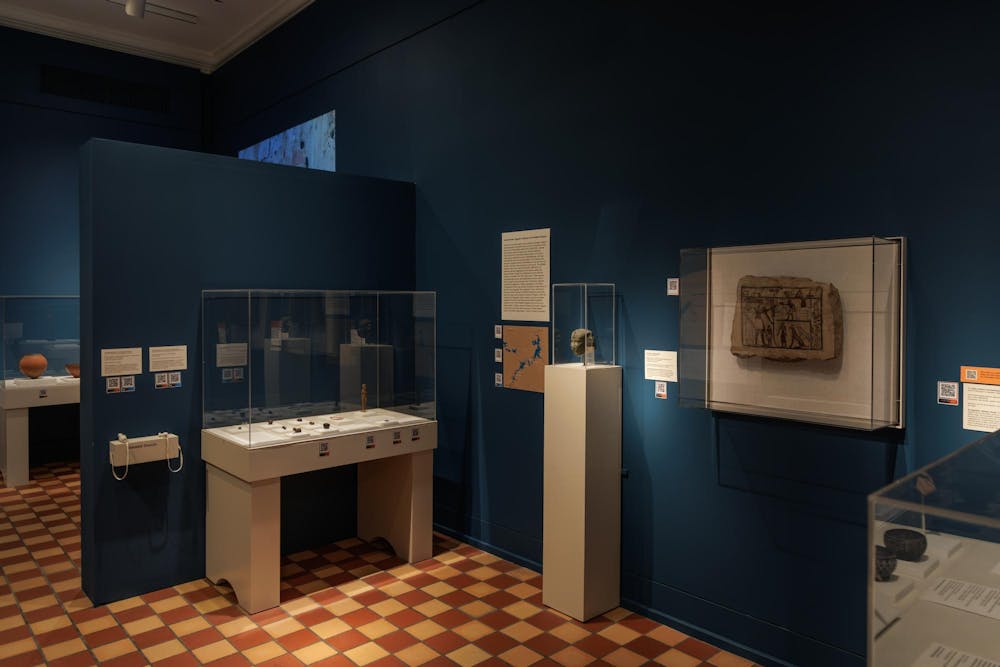The Fralin Museum of Art is currently hosting “The World Between: Egypt and Nubia in Africa,” an exhibit which explores the juxtaposition of having sharp political boundaries, yet blurred cultural ones. The exhibit showcases this complex relationship through a variety of artifacts, such as pottery, statues and figurines, as well as 3D-printed replicas of certain statues that guests are allowed to touch.
Anastasia Dakouri-Hild, curator of the exhibit and professor of art history, said she put the collection together to demonstrate the influence Nubia had on Egypt and educate visitors on how ancient people led normal lives.
“This exhibition shows that people in the past were as complex as they are today,” Dakouri-Hild said. “This does not always come across in textbook descriptions of ancient cultures ... That was my inspiration.”
Nubia, now located in present-day Sudan, comprised several cultures that influenced Egyptian culture, yet their relationship with Egypt is one of volatility — first with Egypt colonizing and occupying Nubia, then later with Nubia doing the same to Egypt. The exhibit works to recognize this dynamism and emphasize Nubia’s overlooked impact on Egyptian culture.
Upon entering, guests are greeted with a panel that describes the exhibit, which moves in chronological order through ancient Nubian history. The only archaeology-focused exhibit at the museum, “The World Between” offers a unique artifact-focused experience to visitors.
An example of an artifact guests will encounter is the “ba” head. In ancient Egyptian belief, the “ba” was the concept of one’s soul and personality, and Dakouri-Hild said the head specifically symbolizes the soul of the deceased flying over its body to reconnect with the person to whom it belongs.
“The concept of the ba as a human-headed kite (bird) flying about the dead body trying to reunite itself with the materiality of a person, as well as the name of the 'spirit,' are Egyptian. This was one of many Egyptian religious and eschatological beliefs.” Dakouri-Hild said.
While a “ba” statue is typically attached to a bird’s body, this artifact is just the head portion. The one at the exhibit is a grey, male head with its eyes closed, though they are typically painted with a variety of colors.
According to Dakouri-Hild, the concept of the “ba” and the practice of building these statues were adopted by those of the Meroitic civilization of Nubia from 300 B.C.E. to 350 C.E. They used this Egyptian eschatological belief and adapted it to their art forms and styles.
This practice of combining animal memorabilia in conjunction with human death is prevalent throughout the exhibit and in ancient Egyptian and Nubian culture. Some other examples guests encounter through the exhibit are the “Jar with Long-Horned Cattle,” a jar with pictures of cattle inscribed on the side of it, and the “Painted Goat Skull,” a goat skull decorated with red, black and white pigments.
“These animals meant literally life or death for agropastoral communities, and they became symbols of human sustenance,” Dakouri-Hild said. “Their blessings were articulated as gifts by life-giving divine entities, and as a result they were associated with gods and goddesses like Hathor and Amun.”
The exhibit also details regionally significant human figures of the time, such as Amenemhat, an indigenous Nubian elite who assimilated into the Egyptian administration. His statue is located in section three of the exhibit and is a replica of the real statue of Amenemhat. The original statue depicts him as a scribe with inscriptions of some of his titles, such as “king’s acquaintance" and “overseer of the king’s worksmen.” The original piece was found buried outside forts that the Egyptians built in the city of Buhen after they had colonized it.
Tyler Glenn, Fralin exhibition intern and fourth-year College student, did hands-on archeological research on the artifacts in the exhibit, including the replica statue of Amenemhat, through a small class taught by Dakouri-Hild last fall and spring semesters. He outlined the extensive process of disseminating each artifact, which to Glenn, revealed the deeper history behind its discovery and preservation.
“The Egyptians went South, colonized all of Nubia and they made these forts.” Glenn said. “You could tell that these [artifacts] were taken from the temple and buried right outside the inner walls of the fortress, under a couple of feet of sand for protection.”
Other artifacts include the sculptures titled “Reproduction of a ‘Reserve Head’ of a Nameless Elite”— a limestone noble’s head with a blank expression — and “Reproduction of a Pregnant Female Figurine.” These two invite physical interaction from visitors, which third-year Architecture student Omer Aziz-Quintana said he appreciated during his visit.
“My favorite part about the exhibit was that there were interactive models that [are] encouraged to be picked up and played with,” Aziz-Quintana said. “I thought it was a really interesting way of having a hands-on way of learning about Egyptian history.”
To accompany these artifacts, there is contextual material throughout the exhibit that further corroborates the nature of the relationship by including key dates, geographical context and further information via QR codes on the artifacts presented. In tandem with the unique cultural parallels found in the pieces, the expositional information solidifies the idea of constant interaction between Egypt and Nubia.
According to Glenn, the exhibit has come at a critical point in the preservation of Nubian history.
With the Sudan National Museum being raided and destroyed in April as part of the Sudanese civil war, it is a great possibility that there are now more Nubian artifacts and art in the United States than in Sudan.
“Nubian archaeology and cultural heritage is now in kind of a short supply,” Glenn said. “...That’s another reason why this Nubian exhibit is so important because it [involves] current geopolitics.”
The threat to Nubian history given the region’s political climate makes recognition of its often underappreciated cultural influences all the more significant. In her curation of “The World Between,” Dakouri-Hild calls attention to the complexities of cultural formation in geographic proximity.
“Egypt would not be 'Egypt' had it not intersected in so many ways with Nubian cultures across time.” Dakouri-Hild said. “Nubia is a very important part of how Egypt came to be the 'civilization' enshrined in public consciousness.”







